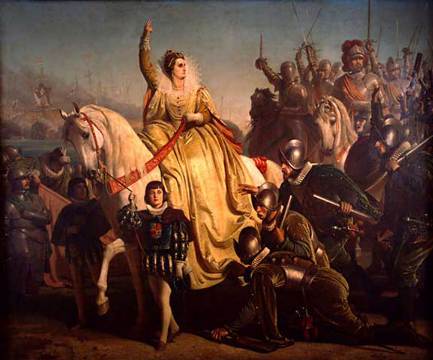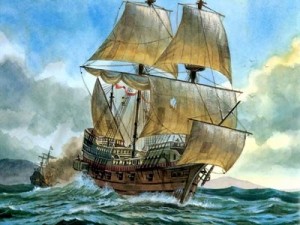Sea dogs of the 1500 and 1600s worked for Queen Elizabeth, robbing and pillaging the Spaniards. Over this period of 200 years many shipments of gold and treasure were stolen from Spanish ships while they were sailing from port to port on the Spanish Main. In one attack the infamous Francis Drake, …surprised and attacked a heavily laden string of 200 mules. The booty that Drake captured in this attack included 30 tons of heavy silver ingots (Cochran 28).
There were many different and obscure English privateers who pirated against the Spanish, but only three of them live on now through their heroic tales. The three most well-known sea dogs include John Hawkins, Sir Walter Raleigh, and Sir Francis Drake. Drake was by far the most popular of all the sea dogs. It is said that he accumulated the most wealth of anyone in the pirating business (Wood 102). Sir Walter Raleigh was another sea dog, but he didn’t prove to be as successful (Cochran 32).
Another pirate during the Middle Ages was John Hawkins. He robbed the Spaniards of slaves and riches (Cochran 26). Together these three men were accountable for what would be worth millions and millions of dollars being converted from Spanish hands to English.
These three sea dogs were not just part-time pirates though. Pirating was their main job. William Wood stated that, …(Spaniards) they were only naval amateurs, compared with the trained professional sea dogs. Drake alone was responsible for over 150 attempted or successful attacks on Spanish treasure ships (Howarth 105).
Drake also accomplished something that only a select few (George Bush) are able to do: he was knighted. One reason many believe he was knighted though was not because of heroics, but because, …a fair share of the immense booty he brought back to England passed quietly into royal hands (Cochran 29). Hawkins and Raleigh also accomplished many great achievements. Raleigh was knighted as well, but even this and many other great feats, are still overshadowed by Drakes clever and bold pirating.
But, if you look at the big picture, these sea dogs were just puppets in a political war between England and Spain. Elizabeth’s reasoning behind having the sea dogs do her dirty work was quite simple: the sea dogs were the best, most successful, and most trained group of naval operators in the world (Wood 170).
Many times the Queen would consult with Drake, Raleigh, or Hawkins on matters of relations with Spain. She would also ask the sea dogs to take reprisal against Spain for any treasure they managed to steal from her (Wood 119). Usually, this revenge would be to either rob back from them or atomize one of their ports. But the destruction was not why they enjoyed pirating. Sea dogs enjoyed pirating for one main reason: it was a fruitful opportunity. In this line of business, you could make a great deal of money depending on how many ships you were able to hit. And the money that we are talking about isn’t small peanuts.
The amount we are referring to would now be considered millions. In fact, Francis Drake made enough money in his life that he was able to contribute funds to Shakespeare’s Globe Theater. But the sea dogs did not just attack treasure ships. They also attacked Spanish colonies and ports. In 1595 Raleigh ransacked the Spanish-held island of Trinidad. He held the tiny city of Saint Joseph at ransom for three days as he robbed all of its inhabitants (Cochran 33).
The deceptive part of robbing a Spanish port was first getting in it though; so, the English would resort to trickery. One time Hawkins needed to have some repairs done on his boat, but he was in Spanish waters, so he sailed into a Spanish port under Spanish flag and color. And as he was docking he rose up against his native English colors and conquered the city – as well as fixed his boat. But the sea dogs were not only involved in stealing gold and riches. They were involved in the highly successful slave trade.
John Hawkins is best known for his involvement in the slave trade. The weird thing about this though, was that most of the slaves were being taken from West Africa and the Canary Islands and being traded to Spain and Portugal (Wood 75). But once the English heard about this, Elizabeth wanted in. So she supplied Hawkins with the ship Jesus of Lubbock, and he and 170 other men set off for Africa.
This trip wasn’t just a slave trade trip though, because on the way home Hawkins captured 7 Spanish ships (Wood 78). So, as you can see, Hawkins was involved in the slave trade with both England and Spain but kept robbing the Spaniards. The author of Pirates of the Spanish Main, by Hamilton Cochran, actually stated that he didn’t think Hawkins was a pirate at all.
He said that he thought that he was actually a privateer, and slave trader. This means that he didn’t steal for himself, but solely for the queen; therefore, he received complete backing from the queen Cochran 25). In 1585 the inevitable war with Spain was fast approaching, (Cochran 29). After many years of terrorized gold ships, King Philip had grown quite irritable of England; so, in 1588 he attacked them in the furious battles of the English channel, (Cochran 29).
The battles of the English channel were between the Spanish Armada and the English navy. At this point in time, the Spanish Armada was considered to be the best navy in the world. But they proved to be no match against the clever and extremely lucky, English navy.
In this famous battle, Drake was the Admiral of the ship Revenge, and Hawkins and Raleigh were vice-admirals of other ships (Howarth 99). But Revenge was not Drakes ship, it belonged to Elizabeth, which proves yet again that England sponsored and supported the English sea dogs. But Drake was not the only pirate sponsored in this battle. The queen gave (Hawkins) financial backing, as did a number of nobles and the lord mayor of London, (Cochran 24/25). But because of Drake’s success, he received the most substantial support from nobles and Queen Elizabeth.
The war between the Armada and England was the proving ground for the idea that the sea dogs were sponsored by the queen. Before the war Elizabeth promoted Drake to chief of the staff to Howard, which means he was the brains behind the English Fleet in this battle (Wood 176). This battle was fought how Drake wanted in to be fought. At one point in the battle the queen sent orders down to Drake to use his own judgment in the battle(Howarth 102).
But the English were lucky that the queen intervened because Drake’s idea was to confront the Spanish in their territory. But the queen opposed (Howarth 101). And it is lucky that she did because the next day the Armada was caught in a ferocious storm. In 1585, before the war broke out, Drake set sail across the Atlantic, …with the most heavily gunned English fleet yet, (Cochran 29). His plan was to go to the main Spanish ports in the Caribbean and shut off the gold flow from there to Spain.
When he reached the Caribbean he put ransoms on the main cities, and started burning block after block until he received payment (finally Spain surrendered Hispanola to Drake.) These attacks on Spanish ports put a damper on, the inevitable war, and bought the English some much-needed time (Cochran 29). As you can see Drake was an amazing pirate and naval mastermind. But, other than pillaging the Spanish he also achieved some very impressive worldly feats.
The Dragon, as Drake was called, became the second man in history to sail around the world; and, probably the first man to sail around the world while robbing the Spanish. Drake was also the first English man to sail around Cape Horn and raid Chile, Peru, and Mexico (Cochran 28). Elizabeth finally realized his success in the English Channel Battle of 1585, and from then on all of Drake’s trips were sponsored by the Queen (Wood 151). She mostly sent him to New Spain (S. America, Caribbean) though, to raid the newly weakened Spanish strongholds.
But in 1596, during another attack on Spain, he fell ill and died. In Drake’s 56 years he led the most successful and profitable life of any other sea dog. Sea dogs brought with them much more than gold, jewels, and fine cloth though. They also brought with them technical advancement in the world of naval operation. In the earlier times of boating the English, as did the Spanish, used large galleon vessels, which were tall, long, and top-heavy.
These boats were excellent because of their capacity for crew members and guns, but they eventually were the downfall of the Armada because of their sluggishness. So in 1587 Hawkins set out to develop a sleeker, faster, and more maneuverable ship. And by the end of the year, he had completed his re-designed vessel (Walker 47).
Before Hawkins had developed this ship the English navy only had twenty-five ships. By 1595 they had 47 ships in their fleet. This increase in numbers was due to the fact that Hawkins ships were smaller, therefore less expensive. And also because at this time the English were at an all-time high for robbing the Spanish, and could then put more money towards their navy. In the latter part of the 1590s, this smaller ship had become the standard for fighting ships in all of England and helped to lead the English to become the naval power of the century (Walker 47). Apparently, Queen Elizabeth knew a good thing when it came along.
Overall, she made millions from Drakes and other pirates’ attacks on King Philip and the Spaniards. So, the reasoning behind the queen’s backing of the sea dogs was simple: she made tons of money from them. She also was able to hinder Spanish development, which was her main objective all along. She was killing two birds with one stone: she was hampering the development of New Spain, as well as putting money in the bank. In the end, the risk for gold was well worth it for the queen, who sponsored and employed the English sea dogs.
BIBLIOGRAPHY
Botting, Douglas. The Pirates. Alexandria, Virginia: Tim Life Books, 1978.
Cochran, Hamilton. Pirates of the Spanish Main. New York: American Heritage, 1961.
Howarth, David. The Voyage of the Armada. New York: Viking P, 1981.
Walker, Bruce. The Armada. Alexandria, Virginia: Time life Books, 1981.
Wood, William. Elizabethan Sea Dogs. New York: Yale U P, 1918.



Check the dates of your eras. The “Middle Ages” or Medieval ends in the early 1400s with the transition to the Renaissance. You refer to them as substantially later.